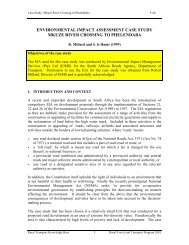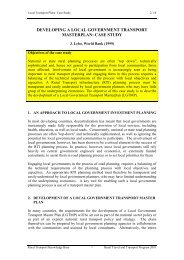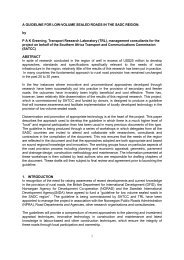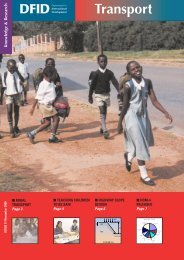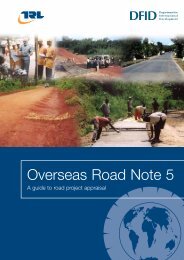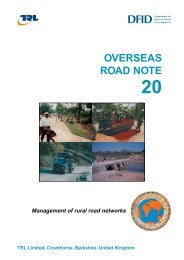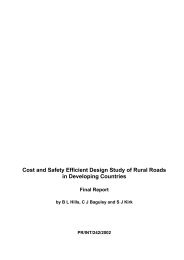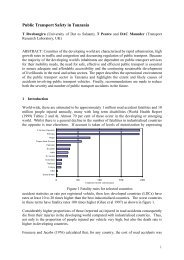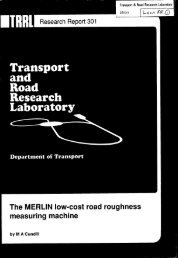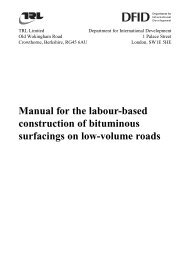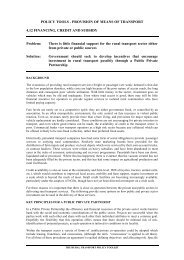LR706 East African Flood Model_ Fiddes - Transport for Development
LR706 East African Flood Model_ Fiddes - Transport for Development
LR706 East African Flood Model_ Fiddes - Transport for Development
Create successful ePaper yourself
Turn your PDF publications into a flip-book with our unique Google optimized e-Paper software.
elatively small storms were recorded. The model was run <strong>for</strong> each large storm on a catchment and <strong>for</strong> a<br />
variety of values of the parameters K and CA. The combinations giving the best agreement between recorded<br />
and predicted floods are listed in Table 1.<br />
4. GENERALISATION OF FLOOD MODEL<br />
4.1 Form of model<br />
The flood model had now been calibrated <strong>for</strong> each catchment. To develop a general flood model the<br />
differences in catchment response to rainfall shown by the individual catchments was next examined. As the<br />
recorded storms varied in severity it was necessary to use the model <strong>for</strong> each catchment to simulate a flood of<br />
a known recurrence interval be<strong>for</strong>e a comparison could take place. A 10 year flood was selected <strong>for</strong> comparison.<br />
~s was simulated by using a 10 year storm profile (see ref 11) and appropriate values <strong>for</strong> the model parameters<br />
K, CA and Y (see 4.2 – 4.4). The results appear in Table 2.<br />
Hydrography, recorded and predicted <strong>for</strong> the largest storms and <strong>for</strong> 10 year floods are shown <strong>for</strong> each<br />
catchment in Figs 2 – 13.<br />
Once estimates of the parameters Y, CA, and K have been made <strong>for</strong> a catchment a design flood could be<br />
estimated by routing a design storm through the computer program. This can be a time consuming process and<br />
<strong>for</strong> many purposes a simpler technique is required. From CA and Y the volume of runoff from any given<br />
design storm can be calculated and if the hydrography shape can be related to the catchment lag time (K), the<br />
peak flow can dso be estimated.<br />
Many research workers have published “dimensionless hydrography” and it has been shown17 that in the<br />
United States these approximate closely to the equation<br />
L 4<br />
where Q = discharge at time T after start of rise<br />
Qm = peak discharge<br />
Tm = time to peak<br />
. . . 4<br />
The most widely used dimensionless hydrography is that of the US Soil Conservation, Service l’. For arid<br />
areas Hickok et alls suggest a somewhat<br />
more peaked shape.<br />
For all of these the ratio of time to peak to base time are very similar. This was not found to be true <strong>for</strong><br />
the <strong>East</strong> <strong>African</strong> catchments studied. For consistency the base time was assumed to be the time from 1 per<br />
cent of peak flow on the rising limb to 10 per cent of peak flow on the falling limb of the hydrography.<br />
Mfined this way, the ratio base time : time to peak is approximately 3.0 <strong>for</strong> the US hydrography. For the<br />
<strong>East</strong> <strong>African</strong> catchments it varied between 2.7 and 11.0. The use of a sin#e hydrography based on time to peak<br />
was there<strong>for</strong>e not appropriate.<br />
A much more stable ratio was found to be the peak flow (Q) divided by the average flow measured over<br />
the base time (~) (Peak How Factor F)<br />
7



